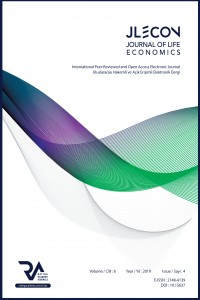Abstract
An undoubted
advantage of the diversified economies is their less sensitivity to dynamics
fluctuations of local sectors and shock destructions. A downturn in one
industry can be compensated by growth in another. Formed in Soviet times
significant industrial potential of Ukraine was not possible to implement only
in the national economy. A significant part of Ukrainian manufacturing and
extractive industries products was consumed by foreign consumers. Formed
absolute and relative advantage in international trade ensured the enrichment
of a limited set of stakeholders and have become the drivers of system economic
crisis and the loss of Ukraine's ability to adsorb (to leap back) shock
disturbance. The results of the analysis indicate the negative impact of
resources specificity on the Ukraine's ability to ensure sustainable
development. Proved the validity of conclusions about the negative effects of
high exports concentration (low commodity diversification) on the economy's
response from shock disturbances
Keywords
export determinant socio-economic resilience concentration diversification structural shifts.
References
- BURLUTSKIY, S., BURLUTSKII Sv. and MARGASOVA, V., (2019), The Relationship Between Short-Term Fluctuations and Stages of Economic Cycle: The Case of Ukraine, Revista ESPACIOS, 40 (10), 10-21.
- CHEN, Y., XIONG, X., (2014), An Empirical Analysis for Over-Sophisticated Export and Regional Economic Growth, Modern Economy, 5, 1114-1119.
- EPPS, T., (2013), Probability and statistical theory for applied researchers. World Scientific Publishing Company, ISBN 978-9814513159.
- NUR DİLBAZ ALACAHAN, YAĞMUR AKARSU, (2017), Foreign Trade Policy of European Union’s Effects on Turkish Economy, Journal of Life Economics, 4(1), 25-38.
- PRIGOGINE, I., (1957), The Molecular Theory of Solutions, Amsterdam: North Holland Publishing Company.
- RAFAEL ROMEU, NELSON CAMANHO DA COSTA NETO, (1999), Did Export Diversification Soften the Impact of the Global Financial Crisis?, IMF: Working Paper 11.
- SERENELLA SALAA, BIAGIO CIUFFOB and PETER NIJKAMPC, (2015), A Systemic Framework for Sustainability Assessmen, Ecological Economics, 119, 314-325.
- SZALAI, A. et al., (1972), The Use Of Time: Daily Activities Of Urban And Suburban Populations In Twelve Countries, Netherlands: The Hague Mouton.
- VAHALIK, B., (2015), Analysis of Export Diversification Development of the European Union and BRICS Countries, Ekonomická revue –Central European Review of Economic Issues, 18, 59-69.
- VON BERTALANFFY, L., (1968), General System Theory: Foundations, Development, New York: George Braziller, ISBN 978-0807604533.
Abstract
An undoubted
advantage of the diversified economies is their less sensitivity to dynamics
fluctuations of local sectors and shock destructions. A downturn in one
industry can be compensated by growth in another. Formed in Soviet times
significant industrial potential of Ukraine was not possible to implement only
in the national economy. A significant part of Ukrainian manufacturing and
extractive industries products was consumed by foreign consumers. Formed
absolute and relative advantage in international trade ensured the enrichment
of a limited set of stakeholders and have become the drivers of system economic
crisis and the loss of Ukraine's ability to adsorb (to leap back) shock
disturbance. The results of the analysis indicate the negative impact of
resources specificity on the Ukraine's ability to ensure sustainable
development. Proved the validity of conclusions about the negative effects of
high exports concentration (low commodity diversification) on the economy's
response from shock disturbances
Keywords
export determinant socio-economic resilience concentration diversification structural shifts.
References
- BURLUTSKIY, S., BURLUTSKII Sv. and MARGASOVA, V., (2019), The Relationship Between Short-Term Fluctuations and Stages of Economic Cycle: The Case of Ukraine, Revista ESPACIOS, 40 (10), 10-21.
- CHEN, Y., XIONG, X., (2014), An Empirical Analysis for Over-Sophisticated Export and Regional Economic Growth, Modern Economy, 5, 1114-1119.
- EPPS, T., (2013), Probability and statistical theory for applied researchers. World Scientific Publishing Company, ISBN 978-9814513159.
- NUR DİLBAZ ALACAHAN, YAĞMUR AKARSU, (2017), Foreign Trade Policy of European Union’s Effects on Turkish Economy, Journal of Life Economics, 4(1), 25-38.
- PRIGOGINE, I., (1957), The Molecular Theory of Solutions, Amsterdam: North Holland Publishing Company.
- RAFAEL ROMEU, NELSON CAMANHO DA COSTA NETO, (1999), Did Export Diversification Soften the Impact of the Global Financial Crisis?, IMF: Working Paper 11.
- SERENELLA SALAA, BIAGIO CIUFFOB and PETER NIJKAMPC, (2015), A Systemic Framework for Sustainability Assessmen, Ecological Economics, 119, 314-325.
- SZALAI, A. et al., (1972), The Use Of Time: Daily Activities Of Urban And Suburban Populations In Twelve Countries, Netherlands: The Hague Mouton.
- VAHALIK, B., (2015), Analysis of Export Diversification Development of the European Union and BRICS Countries, Ekonomická revue –Central European Review of Economic Issues, 18, 59-69.
- VON BERTALANFFY, L., (1968), General System Theory: Foundations, Development, New York: George Braziller, ISBN 978-0807604533.
Details
| Primary Language | English |
|---|---|
| Journal Section | Articles |
| Authors | |
| Publication Date | October 30, 2019 |
| Published in Issue | Year 2019 Volume: 6 Issue: 4 |


